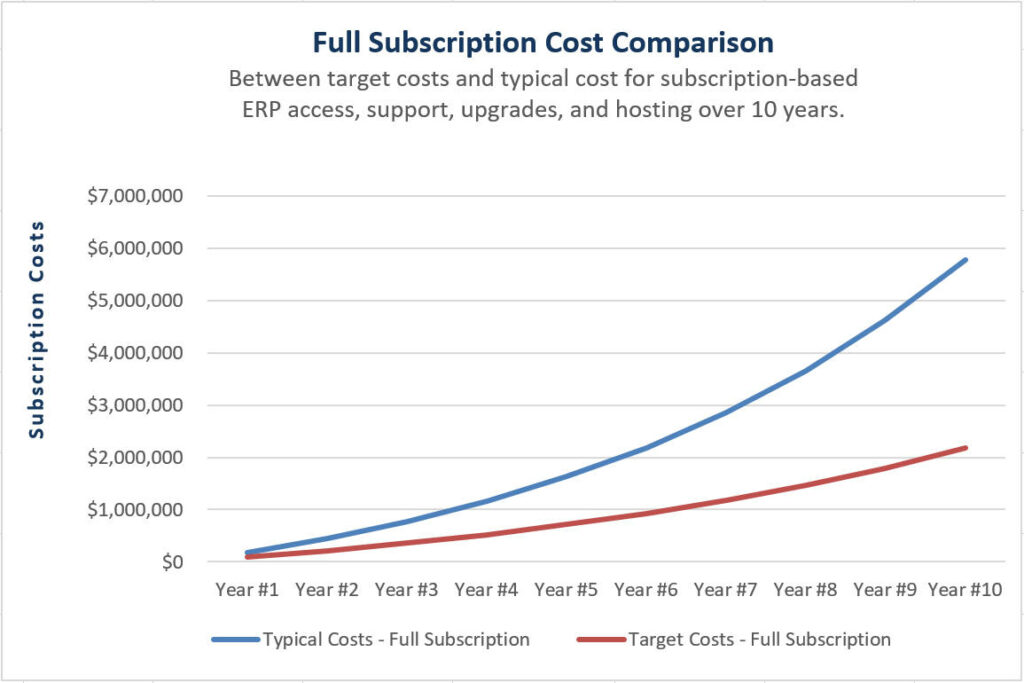The Dark Side of Cloud ERP: Topic #1 – Unnecessary high costs over time
The Dark Side of Cloud ERP:
Topic #1 – Unnecessary high costs over time
The effects of high initial ERP subscription costs and poor cost escalation controls over time make a massive difference in ERP access lifecycle costs. Below is a chart showing what can be achieved and what is typically accepted by a representative manufacturing company with $100 million in yearly sales.
The ERP subscription cost variables
The chart shown here is produced by a financial model that has been used and tuned for years to reflect the cost control variables in the lifecycle costs to access ERP. The cost variable factors considered in this model are described below.
- Initial subscription access costs: Techniques to lower original subscription access costs can result in at least a 50% reduction in what is being presented as the ‘better deal’ from the ERP sellers. There are usually multiple layers of designed confusion in ERP access rights that contribute to compromised purchasing decisions by buyers of ERP access. The model assumes the buyer paid double for initial ERP access rights, over what could have been arranged.
- Purchase more ERP license access in first few years: Buyers cannot really know the proper ERP access rights that they need initially or for the first few years while they get up to ‘full speed’ with the specific ERP. This uncertain access should not be purchased at the start, but arranged pricing (for at least two years) should be arranged so such ERP access can be purchased later. The two key mistakes buyers make are to purchase more access at the start which begins the mounting cost escalation for these components, or (2) they don’t arrange for good-value fixed pricing for these potential future items before committing to an ERP when they have maximum leverage. The model assumes these additional purchases were acquired at double the amount that could have been arranged either in the first purchase or in the first few years when the need was confirmed.
- Purchasing ongoing ERP license access: This cost variable picks up further ERP access after the first few years noted in the prior variable. More access to the ERP is a reasonable assumption as a company grows or its needs change. Further, the ERP sellers are incentivized to create more useful functionality to sell to their existing customers. The model assumes 10% more ERP access is purchased year over year, and that in the typical cost scenario more is paid for these new access rights and new access rights are immediately subject to higher cost escalation terms. The details behind these assumptions include five key more granular assumptions that are too involved for presentation in this article.
- Subscription escalation of any licenses: This is the big cost adder over time. The typical ERP access cost terms have unbounded options to raise the subscription amount over time for original and definitely for future ERP access purchases. The controlled target cost approach scenario seeks a fixed percentage maximum and other mechanisms to control related costs. The ERP sellers put a lot of effort into determining what the maximum increase amounts would likely be for their customer base . . . without triggering an exodus of customers. And remember, buyers will take a lot of abuse based on the extreme difficulty to retrofit ERP. The model assumes 5% increase year-to-year over time with the target cost and terms, and the typical cost approach assumes 10%.
If your company is seeking new ERP but your processes and size are steady, then the estimated ERP access cost difference demonstrate here would likely be less. If your company is projected to need more than 10% new ERP capacity per year, then lifecycle costs will likely be worse than what is demonstrated in this article.
Decades of experience has established a hard reality about the ERP industry—which is its core business purpose is to pull in ERP users in most any way they can, but to do so without ERP access cost escalation controls. Then over time, to exploit the unbounded options for high pricing for new ERP access and escalation on existing subscription charges. ERP company valuations are greatly affected by how well they play this game.
ERP - Arguably the hardest commercial relationship to escape . . . So get it right at the start.
Information in these articles is based on the experience of over 1000 ERP projects conducted since
1996 in which the ERP buyer's interests and well-being was the sole focus.

